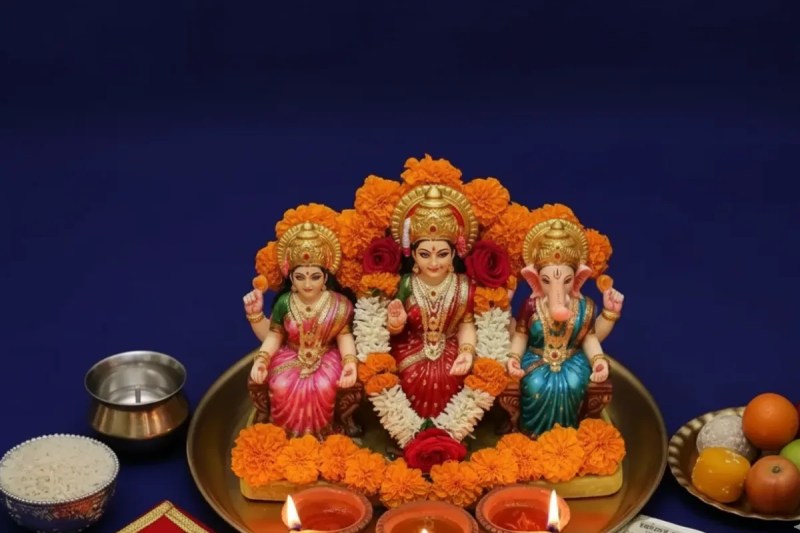
Diwali (Image: AI)
Diwali 2025Lakshmi Puja 2025 Timing: The night of the Amavasya (new moon) of Kartik Krishna Paksha... when every home is illuminated by the glow of lamps, it is not just a festival, but a great confluence to receive the blessings of Goddess Lakshmi, Ganesha, Mother Saraswati, and Mother Kali. This year, on Diwali, celebrated on October 20 and 21, 2025, although the time for Lakshmi Puja may be short, its significance is immense. If you wish for happiness and prosperity to remain in your home throughout the year, you must note this essential information!
According to astrologers, the Pradosh Kaal (twilight period) is considered the most auspicious and fruitful time for Lakshmi Puja on Diwali. This is the time that begins immediately after sunset, when the atmosphere is most charged with positive energy.
| Auspicious Time for Puja (October 21, 2025) | Time |
| Great Confluence for Lakshmi Puja | 05:50 PM to 05:56 PM (Only 6 minutes!) |
| Pradosh Kaal (to continue the puja) | 05:50 PM to 08:18 PM |
| Mahanishith Kaal (for Tantrics/Sadhaks) | 11:36 PM to 12:25 AM (late night) |
Morning (Chal, Labh, Amrit): 09:05 AM to 01:28 PM
Afternoon (Shubh): 02:55 PM to 04:23 PM
Important Note: This year, you must pay special attention to complete your main puja during this 6-minute auspicious confluence.
According to mythological tales, on the night of Kartik Amavasya, Mahalakshmi herself descends to Earth and visits every home. Where there is cleanliness and light, she resides in a part of her essence.
Purification and Decoration: On Diwali, thoroughly clean the entire house and sprinkle Gangajal (Ganges water) for purification.
Rangoli and Entrance: Create beautiful Rangoli at the main entrance of the house and near the puja area.
Setting up the Chowki: Place a chowki (low stool) covered with a red cloth at the puja spot. Install idols or pictures of Goddess Lakshmi, Mother Saraswati, Lord Kuber, and Ram Darbar on it, with Lord Ganesha placed to the right.
Kalash and Lamp: Place a Kalash (water pot) filled with water in the north direction. Place a large ghee lamp in the Agni Kon (South-East) so that it burns throughout the night.
Incense, lamps, water, Mauli (sacred thread), turmeric, Abir-Gulal (coloured powders), rice.
Fruits and flowers (especially lotus flowers), sweets, jaggery.
Betel leaf, betel nut, cloves, cardamom, and Kamalgatta (lotus seeds) must be included.
Keep all new items/jewellery purchased on Dhanteras at the puja spot.
After the puja, light lamps in every corner of the house. Ensure that a large lamp of ghee and another of mustard oil remain lit throughout the night in the temple.
Light 13 or 26 Diyas Today: Light diyas in every corner of the house, especially near the Tulsi plant and at the main entrance.
Why is Mother Kali worshipped? - On the night of Diwali, there is also a tradition of worshipping Mother Kali. Especially in Bengal, Odisha, and Assam, it is celebrated as Kali Puja. They are worshipped during Mahanishith Kaal (midnight) to destroy evil forces and bring balance to life.
Significance of Kuber Puja: On Diwali, not only Goddess Lakshmi but also the god of wealth, Lord Kuber, is worshipped. Kuber Puja ensures that wealth remains in the vault. Therefore, an idol or Yantra of Lord Kuber must be kept during the puja.
At the end of the puja, be sure to sing this Aarti of Mother Lakshmi:
Om Jai Lakshmi Mata, Maiya Jai Lakshmi Mata. Tumko Nishidin Sevat, Hari Vishnu Vidhata. Uma, Rama, Brahmani, Tum Hi Jag-Mata. Surya-Chandrama Dhyavat, Narad Rishi Gata.
Published on:
21 Oct 2025 03:06 pm
Big News
View AllAstrology and Spirituality
Trending

